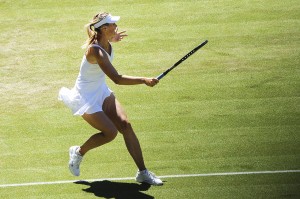chicks with balls: the state of women’s tennis
Join Ally Van Schilt for Lip’s new fortnightly women’s sport column: Chicks With Balls!
Recently, Maria Sharapova defeated Simona Halep in the women’s singles final at the French Open, defending her title from 2012 and taking her total number of grand slam championships up to five, and her current ranking to fifth in the world. Throughout the tournament, she was ranked seventh. At the age of 27, there can be no disputing that Sharapova is a certified champion of the women’s singles tennis world.
Sharapova defeated Halep in a three-set match 6-4, 6-7, 6-4. Meanwhile, in the men’s singles final, Rafael Nadal maintained his incredible record on clay (having lost just one of over fifty of his previous encounters in France), by defeating Novak Djokovic 3-6, 7-5, 6-2, 6-4. There’s no doubting that both Sharapova and Nadal deserve their titles, and all of the acclaim that they are receiving, due to their phenomenal athletic abilities and their ongoing success in the sport.
But what exactly is the state of women’s tennis? It may seem a funny question to ask, but there has been plenty of criticism, both of late and ongoing for many years, over the state of the women’s game. The basic rules of tennis mean that a match of women’s tennis is seemingly similar to a match of men’s tennis; but at the same time, it is also quite different. In order for a man to win his match, he must win the best of five sets. However, in order for a woman to win her match, she must only win the best of three sets. This means that a men’s match of tennis could go for double the time that a women’s match will. As a result, this means that the men’s game gets a lot more airtime, a lot more exposure, publicity and generates more interest than the women’s game from a purely logistic point of view.
This is common knowledge, and just about the only thing that differentiates the two. But the question which arises with just about every major grand slam tournament is around why this is the case. Are we implying that men are fundamentally, essentially stronger bodied than women? Are we implying that they have more athletic capability? Are women not made for endurance of a longer match? Or is it that the public want to see men play tennis more than they want to see women play tennis.
In this day and age, it does seem odd that women are still viewed to be ‘weaker’ than their male counterparts in the sporting world. After all, in other sports there is definite gender equality. Men and women swim the same lengths, run the same distances and play for the same amount of minutes. Why then is tennis still stuck on this ideal than the women’s game needs to be shorter?
With such powerhouse females playing the game in this era, including Sharapova, the Williams sisters, Li Na and Australia’s Samantha Stosur, there’s no doubting that the athletic prowess and fitness capabilities of these women mean that they could last in a best of five match. The only thing restricting them from playing an equal game with the men are the rigid rules of tennis, which have been in place for many, many years. Isn’t it time that the governing bodies looked at enforcing equal match times for males and females? This would result in more interest in women’s matches, higher crowd numbers, more revenue for venues, players, coaches and referees, more media coverage and, most importantly, equality in pay, game time and acknowledgement of ability between the players.
Recently, the women’s game has come under fire from Australian tennis player Marinko Matosevic, who criticised Andy Murray for hiring former world number one female tennis player Amelie Mauresmo as his coach. ‘For me, I couldn’t do it because I don’t think that highly of the women’s game’, the world number 60 stated. Now, clearly this comment from Matosevic is an ignorant and sexist remark that really doesn’t deserve any more publicity than it has already received (luckily, criticism for him has come thick and fast from all angles). But ‘not thinking highly of the women’s game’ is a criticism which has come from many different standpoints due to its imbalance with regards to the men’s game. So is it about time that we seriously looked into changing the way that tennis is played for our female athletes? Or should we stick by the traditional tennis formatting?
Stay tuned for Ally’s next instalment of Chicks with Balls in a fortnight on Lip, for all your women’s sporting news and opinions.


